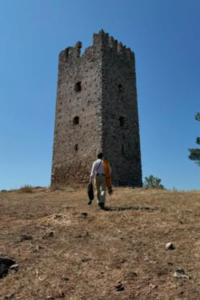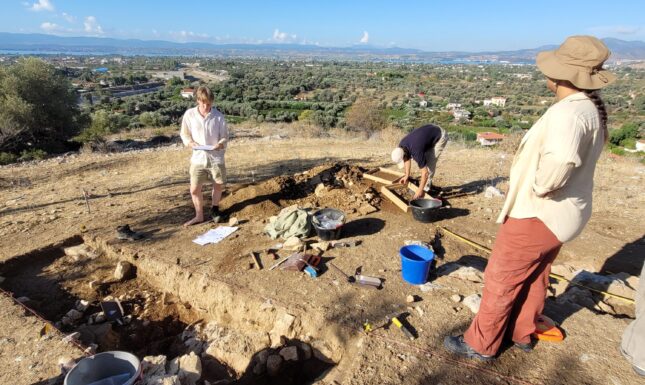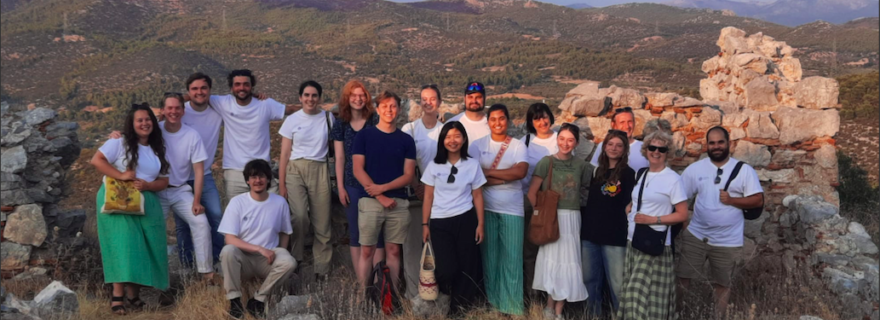The Hinterlands of Medieval Chalcis Project Unearths a Medieval Landscape in Rural Greece
Hinterlands of Medieval Chalcis Project (Archaeology, Leiden) has a successful third year of fieldwork in Greece.

When travelling to Chalcis, a striking aspect of the landscape is the tall stone towers. Over 100 towers remain standing, sometimes in villages or remote hilltops. However, it is not immediately clear what purpose the towers served: who built them, and why?
This is one of the research questions being investigated by the ‘Hinterlands of Medieval Chalcis Project’ (HMC). Overall, the project seeks to provide a better understanding of the relationship between the countryside and the city of Chalcis in the late Middle Ages. From August to September 2024, the Hinterlands of Medieval Chalcis Project (HMC Project), directed by Professor Joanita Vroom (Archaeology of Medieval and Early Modern Eurasia, Leiden University) and Dr. Alessandra Kostarelli (Ephorate of Antiquities of Euboea), conducted its third field season on the Greek Island of Evia (Euboea).
The Historical Background
The late Middle Ages in Chalcis saw a rapid succession of rulers vying for power. Byzantines, Crusaders, Venetians, and Ottomans sought control of the city because it controlled the Euripus Strait. Due to its strategic location, Chalcis became a hub for inter-regional trade during the Middle Ages, with its own ceramics industry exporting products throughout the Mediterranean. It was an important harbour settlement that in medieval times became known as Negroponte by the Latin-Venetian conquerors who settled in Greece. In 1470, the Ottoman army captured the city through a long siege, and it remained under Ottoman control until the Greek Revolution of 1821.
The textual sources about this period contain a range of contrasting perspectives. Writing shortly before 1687, British traveller Bernard Randolph remarked that the countryside was largely depopulated of its former Greek inhabitants, and drew attention to the Albanian shepherds in the countryside. Evliya Celebi, an Ottoman traveller who visited the region from 1667-1670, described the villages as wealthy and prosperous, and their inhabitants as Greek.
Whereas one writer sees massive destruction and depopulation, another sees countryside life continuing as it always has, largely uninterrupted by changing rule. It is possible that the accounts of both writers must be taken with a grain of salt, as they were both shaped by the worldviews of their authors and the expectations of their audiences. Bernard Randolph's account belongs to the literary topos that was popular in England at the time: that of the Terrible Turk, as exemplified through A Christian Turn'd Turk, a popular play written by Robert Daborne in 1612 about a real English pirate named John Ward who gave his allegiance to the Ottoman Sultan.
Meanwhile, Evliya Celebi was born in Istanbul in 1611 to a wealthy family attached to the Ottoman court. Though he remained connected to the court throughout his life, he nevertheless prioritized his love for travel, journeying throughout the Ottoman Empire and recording his observations in his travelogue, the Seyahatname.
For Ottoman statesmen like Evliya Celebi, the Ottoman Empire meant the existence of peaceful realm stretching from the Caucasus in the east to Algeria in the west, and from the Danube in the north to the Nile in the south. Throughout this pax ottomanica, a traveller could rely on a consistent and dependable system of laws, a shared administrative language, and a relative degree of safety. As a result, Evliya Celebi travelled to almost every part of the Ottoman Empire between 1630 and 1672, arriving in Chalcis ca. 1667.
Due to the partial and often contradictory nature of the textual record, archaeological evidence becomes a way to provide an additional perspective - though that too is bound by its own limitations. Archaeological field surveys can perhaps show the rise and fall of rural populations over time, through careful quantification of surviving potsherds and other artifacts. This data can then be compared against the archaeological record of the city of Chalcis itself, previously investigated by a team under the guidance of Professor Joanita Vroom through a rescue excavation at 10 Orionos Street.
Consultation of the surviving tax registers and other documentary evidence of Chalcis provides additional context, and can help us to understand the movement of people between countryside, city, and beyond.

Current Archaeological Research
In the 2024 field season, team members of the HMC project included researchers, graduate students, and undergraduates from Leiden University, the University of Sheffield, and the University of Manchester, in addition to project members from the Ephorate of Antiquities of Euboea (EAE) and the Hellenic Society for Near Eastern Studies (HSNES) in collaboration with the Netherlands Institute at Athens (NIA).
Since 2013, Leiden University researchers and students have been studying the city of Chalcis and its hinterland together with Greek and British colleagues. The 2024 campaign was in all aspects very successful, helped by a prestigious grant from the Packard Humanities Institute (PHI), a California-based non-profit organization dedicated to archaeological research. During the 2024 fieldwork season, trial trenches were opened near the Mytikas towers, two stunningly well-preserved medieval high-rising structures, unearthing well-stratified contexts dating from ca. the 12th to 15th centuries CE, and also from the 19th and early 20th centuries. Further excavation is needed to confirm the extent to which these chronological periods continue throughout the site.
Various international specialists were invited to the project for their expertise in analyzing the glass and metal finds, while graduate and undergraduate students processed, identified, and dated the project’s ceramic finds under Vroom’s supervision. This research shows the role of rural medieval settlements in regional and inter-regional production and exchange networks, and also traces the rise, prosperity, and decline of Byzantine amphorae (ceramic transport jars for bulk goods) in the eastern Mediterranean.
In addition, intensive and extensive surveys allowed the project to study the countryside in detail, and to archaeologically document numerous previously unpublished or unknown sites. By combining the rich and multifaceted archaeological data collected by the project with historical textual sources and geophysical information, the HMC project has been able to make major steps forward in 2024 in its endeavor to build a detailed and completely new understanding of medieval life in Chalcis and surrounding areas.


Conclusions
While research is far from complete, the archaeological research so far indicates that the archaeological record is able to provide a level of nuance and detail that cannot be gained from textual sources (of British and Ottoman travellers) alone. Only time will tell the full story of medieval and post-medieval inhabitation of the hinterlands of Chalcis, and the HMC project looks forward to continuing its research.
Recommended reading:
- Panagopoulou, A.P., Vroom J., Hein, A., Kilikoglou V. and E. Tzavella 2024. A pilot study of Byzantine amphorae from Chalcis: Technological development in manufacturing. Pharos 25 (2021-2023), 141-160.
- Randolph, B. 1983. The Present State of the Islands in the Archipelago (or Arches). Oxford, 167. Reprinted Athens: Dionysiou bookstore Nati Karavia.
- Vroom, J. 20142, Byzantine to Modern Pottery in the Aegean. An Introduction and Field Guide, Second and Revised Edition. Turnhout: Brepols Publishers (1st printing 2005, Utrecht: Parnassus Press).
- Vroom, J. 2022. Shifting Byzantine networks: New light on Chalcis (Euripos/Negroponte) as a centre of production and trade in Greece, in: E. Fiori and M. Trizio (eds.), The 24th International Congress of Byzantine Studies, Volume 1: Proceedings of the Plenary Sessions. Venice: Edizioni Ca’Foscari, 453-487
- Vroom, J., Kostarelli, A., Blackler, A., Kalantzis-Papadopoulos, D. and R. Kolvers 2024. The Hinterland of Medieval Chalkida: A preliminary overview of the 2021 and 2022 fieldwork seasons. Pharos 25 (2021-2023), 179-234.
- Vroom, J., Tzavella, E. and Vaxevanis, G. 2023. Life, work and consumption in Byzantine Chalcis: Ceramic finds from an industrial hub in central Greece, ca. 10th-13th centuries, in: J. Vroom (ed.), Feeding the Byzantine City: The Archaeology of Consumption in the Eastern Mediterranean (ca. 500-1500) (Medieval and Post-Medieval Mediterranean Archaeology Series V). Turnhout: Brepols Publishers, 223-260.
- Zilli, M. (Evliya) 2010. Evliya Çelebi Seyahatnamesi. Translated by Seyit Kahraman. Vol. 8/1. İstanbul: Yapı Kredi Yayınları.



0 Comments
Add a comment